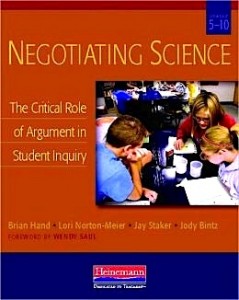Negotiating Science through Writing
A MiddleWeb Book Review
Negotiating Science: The Critical Role of Argument in Student Inquiry
By Brian Hand, Lori Norton-Meier, Jay Staker, and Jody Bintz
(Heinemann, 2009 – Learn more)

If you want your students to think more critically or take ownership for their learning, the 2009 book Negotiating Science may be for you. While I found the ideas in the book engaging, I felt that the title was a bit misleading. Negotiating Science explains an entire process, which the authors call a ‘science writing heuristic’ (SWH). Negotiating and argumentation is a piece of that process, but the book is about so much more.

SWH revolves around students crafting testable questions from teacher-determined big ideas, conducting investigations, making observations, and then developing claims based on their observations. Once the students have developed claims, then they find out how their ideas compare with others. This step is where the negotiation takes place.
Students read, talk with scientists, and talk with their peers. They discuss all of the ideas and argue the evidence and claims to come to a greater understanding of the concepts. Finally the students reflect on their learning and how their ideas changed throughout the process.
I really appreciate that Hand et al. followed the basic SWH method when writing Negotiating Science. Although I read this book on my own, I feel that it would be best read with a peer or group. Negotiating Science is infused with ideas, questions and the “Have a Go” section that encourages educators to really reflect on their teaching; much of this involves dialog with others.
What’s in the book
The authors have infused teacher and student voices throughout the book, including student work samples and educator reflections on transitioning to the SWH process in their classrooms. Hand et al. recognize that the transition from a conventional science classroom to SWH involves cognitive dissonance and hard work (both for teachers and students). But the outcomes, of course, are worth it.
Using a method like SWH, students become active learners, build their own knowledge, make connections, reflect on their learning, write, and write some more. Students write informally for younger audiences explaining their ideas. Students defend their knowledge publicly through writing. Students author letters, books, etc. espousing scientific concepts for the general public.
While reading Negotiating Science, I came to the conclusion that I already use many of the pieces of SWH, but do not use them consistently. The idea of students consulting the experts after they investigate the ideas on their own is different from the way I typically teach the scientific method, but I definitely see the value of that order as Hand et al. lay it out. I particularly like the way they use concept maps to help the students keep track of their learning progression. As an educator I recognize the value of self-reflection, and using concept maps for this process seems like a good format.
Some questions I have
It seems to me that SWH is ideal for physical science and other concepts that are easily tested by middle school students. I’m not sure, however, how you would use it for other concepts. The authors addressed this briefly with a biomes example. In this unit, the students “tested their questions” by consulting posters and other print sources. To me this did not seem to be truly testing ideas or following the SWH sequence of comparing your ideas with the experts after you make your own claims. Without the opportunity to pose the question to the authors about teaching more abstract concepts, I’m not sure how Hand et al. would propose to deal with these issues.
Another concern I had when reading Negotiating Science was about the students who may cling to misunderstood ideas for too long. Unlike my above question, the authors do address this in the book. The authors’ premise is that when those students get to the negotiating stage they will come to realize their flaws. I recognize that for me cognitive dissonance is a powerful learning tool, so I understand their point about this; however, over the years I have taught several middle school students who did not give up their misconceptions about a topic despite the evidence presented them.
Granted, I was not following the SWH method when this happened, but I have doubts that those students’ ideas would change even with this method in play. Extrapolating that to students who may not initially have strong ideas about a concept, what happens when they progress through SWH holding on to misunderstandings? Will they still hold fast to those even after negotiation?
Thought-provoking and valuable
Despite these two concerns, I am glad I read Negotiating Science, which I found informative and thought-provoking. I have already begun modifying the SWH method to fit my classroom. I particularly like the ideas for student’s defending and explaining their knowledge in writing. It seems like an ideal way to truly assess what the students know and understand.
Tracey Muise, currently at St. George’s Episcopal School in Milner, GA, has been engaging and challenging middle school students for over 15 years in a science classroom. Previously she taught at the Episcopal School of Knoxville (TN), Girls Preparatory School (Chattanooga, TN) and the Edmund Burke School (Washington, DC). She earned her M.S. in environmental education in 1996 from Antioch New England Graduate School and her undergraduate degree in biology, in 1990, from Drew University.


































